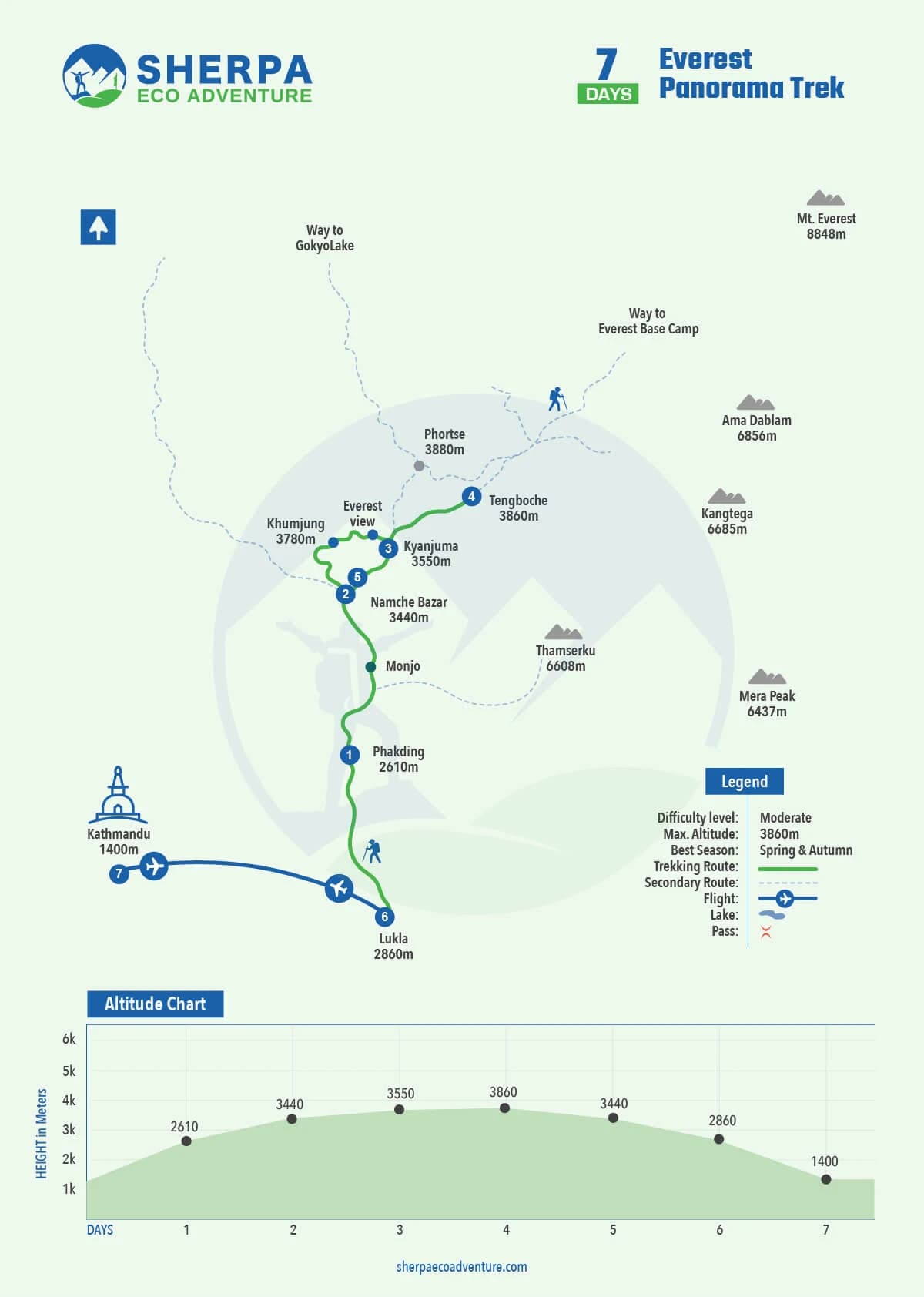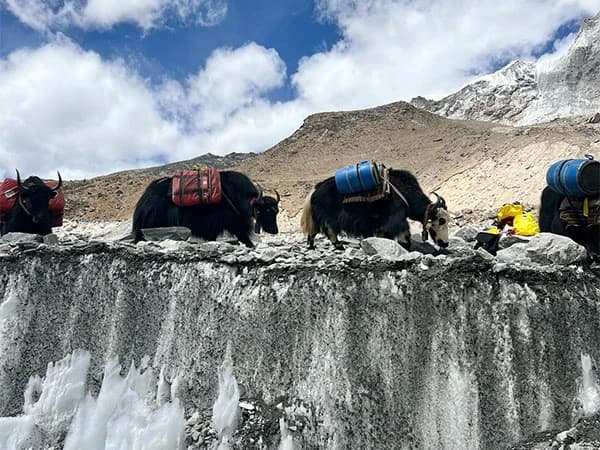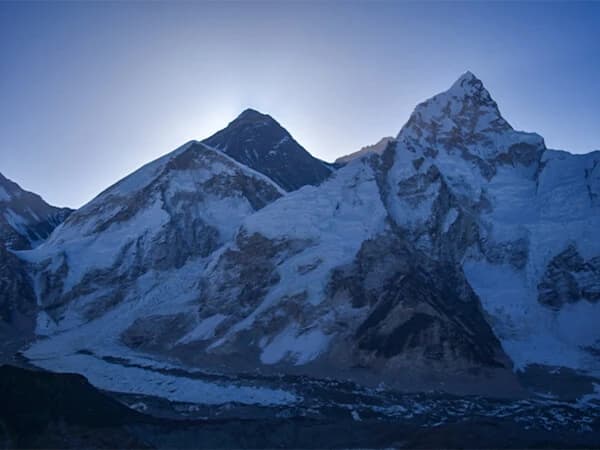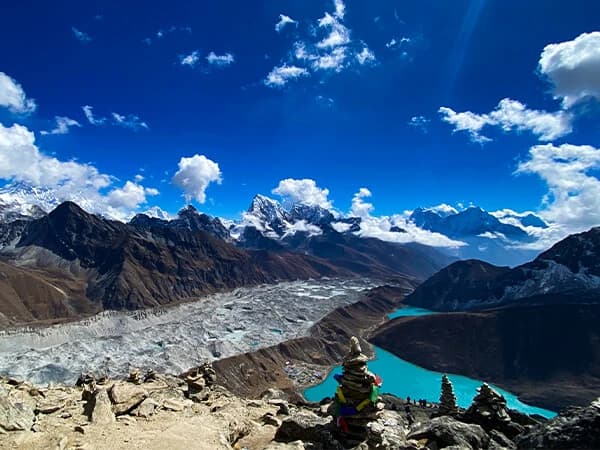Trekking to Namche Bazaar in the Everest region of Nepal is a captivating adventure that blends stunning Himalayan vistas, vibrant Sherpa culture, and exhilarating trekking experiences with the Everest Panoram View. Situated at an elevation of approximately 3,440 meters, Namche Bazaar serves as a pivotal acclimatization point, allowing trekkers to adjust to the altitude while exploring its bustling market town atmosphere.
Typically, the journey starts with a picturesque flight from Kathmandu to Lukla and then involves a trek through beautiful scenery while crossing suspension bridges over the raging Dudh Koshi River. As trekkers ascend towards Namche Bazaar, they are treated to panoramic views of iconic Himalayan peaks, including Mount Everest, Lhotse, and Ama Dablam.
Along the way, encounters with Sherpa villages, monasteries, and the unique Sherpa culture provide insights into the region's rich traditions. The trek, offering a moderate level of difficulty, emphasizes the importance of proper acclimatization, with Namche Bazaar serving as an essential resting point before venturing further into the Everest region.
Moreover, obtaining necessary permits, such as the Sagarmatha National Park entry permit and TIMS card, and adhering to local regulations enhance the trekking experience, ensuring respect for the environment and cultural heritage of this awe-inspiring region.
Highlights
- Gateway to Everest: Namche Bazaar is often considered the gateway to Everest and is an essential stop for trekkers heading to Everest Base Camp or other regions in the Everest region.
- Stunning Scenery: As you trek towards Namche Bazaar, you'll experience breathtaking views of the Himalayan peaks, including Mount Everest, Lhotse, Ama Dablam, and many others.
- Sherpa Culture: Namche Bazaar is the cultural heartland of the Sherpa community. While here, you can immerse yourself in Sherpa culture, traditions, and hospitality. You can visit local monasteries, learn about Sherpa history, and interact with the locals.
- Acclimatization: Namche Bazaar is situated at an altitude of around 3,440 meters (11,286 feet). Spending a day or two here allows trekkers to acclimatize to the higher altitude, which is crucial for further ascent.
- Local Market: Namche has a vibrant local market where you can purchase trekking gear, souvenirs, local crafts, and taste local delicacies. It's a hub of activity and offers a glimpse into the local economy and lifestyle.
- Scenic Trails: The trek to Namche Bazaar offers a mix of terrains, from dense forests of rhododendron and pine trees to suspension bridges spanning deep river gorges. The trail is scenic and provides ample opportunities for nature photography.
- Hiking Opportunities: From Namche, there are several day-hike options available. You can hike to the Everest View Hotel for stunning panoramic views, visit Khumjung Village to see the famous Yeti scalp, or trek to the nearby monasteries like Tengboche.
- High-altitude Experience: Staying in Namche Bazaar allows trekkers to experience life at high altitude. The thin air, cold temperatures, and rugged terrain offer a unique adventure experience.
- Tea Houses and Accommodation: Namche Bazaar has several tea houses, lodges, and accommodations catering to trekkers. You can enjoy a comfortable stay, taste local food, and interact with fellow trekkers from around the world.
- Gateway to other Destinations: Apart from being a stopover for Everest Base Camp trekkers, Namche Bazaar also serves as a gateway to other trekking destinations in the Everest region, such as Gokyo Lakes, Everest Three Passes, and Island Peak.
What should I expect during the Everest-Panoram trek?
The trek to Everest Panoram in Nepal's Everest region promises adventurers a harmonious blend of natural splendor, cultural immersion, and physical challenge. As trekkers ascend through picturesque landscapes, they are greeted by breathtaking vistas of iconic Himalayan peaks like Mount Everest, Lhotse, and Ama Dablam. The journey unfolds through diverse terrains, from verdant forests and roaring rivers to alpine meadows and glacial moraines, necessitating a moderate level of physical stamina and acclimatization.
Amidst this scenic backdrop, Everest Panoram emerges as a vibrant Sherpa market town, offering a window into local life through bustling markets, traditional teahouses, and ancient monasteries. The rich Sherpa culture resonates throughout the trek, fostering meaningful interactions and insights into customs, cuisine, and community spirit.
Furthermore, trekkers navigate changing weather patterns, requiring layered clothing and essential gear to adapt to varying conditions. Overall, the trek to Everest Panoram encapsulates an unforgettable Himalayan adventure where natural beauty, cultural experiences, and physical endurance converge, creating lasting memories amidst the awe-inspiring landscapes of the Everest region.
Is Everest Panoram trekking right for you?
Determining if the Everest Panoram trekking experience is suitable for you hinges on several factors that encompass fitness, altitude tolerance, trekking experience, cultural respect, and personal expectations. The trek, considered moderate in difficulty, demands a reasonable level of fitness due to the varied terrain, including ascending and descending trails amidst the Himalayan landscapes.
Additionally, acclimatization to higher altitudes, respecting local customs and environmental conservation practices, and understanding the realities of multi-day trekking expeditions are crucial elements for a safe and enriching experience.
If you possess a level of fitness conducive to trekking, have an appreciation for Sherpa culture, are prepared for altitude challenges, and align your travel expectations with the realities of the trek, the Everest Panoram trek offers a rewarding adventure filled with breathtaking vistas, cultural immersion, and memorable experiences in the heart of the Everest region within a relatively short period of time.
Perks of doing the Namche Bazar Trek with us.
Commencing on the Everest Panoram trek with a Sherpa Eco Adventure offers several perks that enhance your overall trekking experience in the Everest region of Nepal. Here are some advantages to choosing to trek with a travel company:
- Expert Guidance: Benefit from experienced guides with expertise in researching routes, local culture, and environmental considerations.
- Logistical Convenience: Enjoy seamless arrangements for permits, transportation, accommodation, and meals.
- Customized Itineraries: Receive personalized trekking plans tailored to your preferences, fitness level, and time constraints.
- Safety Measures: Prioritize safety with trained guides, emergency support, and protocols for altitude sickness management.
- Cultural Insights: Gain deeper knowledge of Sherpa culture, traditions, and Himalayan ecosystems through informative guidance.
- Group Camaraderie: Engage with like-minded adventurers, fostering social interaction and shared experiences.
- Sustainable Tourism: Support responsible tourism practices, contributing positively to the local economy and environment
- Exemplary Service: top-notch service and heartwarming hospitality.
- Value: The best Everest Panorama Trek Cost
- Availability: 24/7 support system
- Inclusion: Complementary farewell dinners and airport transfers as per itinerary
- Transparent: No hidden cost
.webp&w=3840&q=75&dpl=dpl_B22n3RDZYE3wLXxwUTJy6N9BzP8b)



